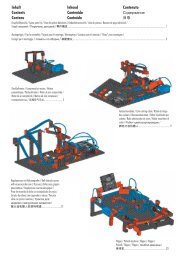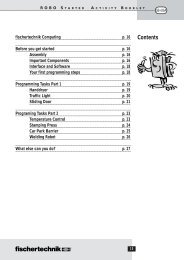didactic activity booklet - Fischertechnik
didactic activity booklet - Fischertechnik
didactic activity booklet - Fischertechnik
Create successful ePaper yourself
Turn your PDF publications into a flip-book with our unique Google optimized e-Paper software.
PROFI HYDRO CELL KIT INSTRUCTION MANUAL<br />
16<br />
Hydro Cell Kit<br />
How does a fuel cell work? How can you produce hydrogen with it? The Hydro Cell Kit provides<br />
knowledge for all areas associated with this exciting topic. With the fuel cell and the additional<br />
solar module, interesting additional models can be built in connection with the construction set,<br />
Profi Oeco Tech. The instructional <strong>activity</strong> <strong>booklet</strong> in the Profi Oeco Tech kit offers assistance.<br />
All of your questions are answered.<br />
Important instructions on use of the Hydro Cell Kit<br />
The Hydro Cell Kit is an extension kit. You will also need the Profi Oeco Tech kit (Item # 505284)<br />
to operate the fuel cell and to perform the experiments in this instruction manual. Alternatively,<br />
you can also use the Profi Oeco Power kit (Item # 57485).<br />
Safety Instructions<br />
� The fuel cell may only be operated with a direct voltage up to 2 V. Never connect<br />
other, e.g. 9 V fi schertechnik power supplies.<br />
� Do not short circuit the contact points of the fuel cell.<br />
� Too high voltage or a short circuit can destroy the fuel cell membrane.<br />
� Do not use the fuel cell for:<br />
The production of electricity and hydrogen for any purposes other than those given in the<br />
instruction manual.<br />
The production and/or storage of more hydrogen than fi ts in the storage cylinder of the fuel<br />
cell (around 15ml).<br />
Continuous electrolysis.<br />
� The fuel cell produces hydrogen. Hydrogen is an extremely fl ammable gas. No<br />
naked fl ames near the components!<br />
Proper Use<br />
The Hydro Cell Kit's fuel cell may only be used to operate fi schertechnik models.<br />
2 HKC_GB.indd 16 27.07.2009 13:47:32
How the Fuel Cell Works<br />
PROFI HYDRO CELL KIT INSTRUCTION MANUAL<br />
■ A fuel cell converts the chemical energy of a fuel (e.g. hydrogen) into electric current<br />
(electricity). A fuel cell is therefore not an energy store but an energy converter.<br />
Fuels cells are used, for example, to drive vehicles and to supply homes with heat and<br />
electricity.<br />
A fuel cell consists of two electrodes (anode and cathode), which are separated from each<br />
other by an electrolyte membrane.<br />
The electrodes are made from metal or<br />
carbon. They are coated with a catalyst, for<br />
example, platinum or palladium.<br />
Inside the fuel cell, hydrogen and oxygen<br />
react to form water. This reaction produces<br />
an electric voltage between the two electrodes<br />
which can be used, for example, to<br />
drive an electric motor.<br />
■ The fuel cell included in the Hydro Cell<br />
Kit is a so-called reversible fuel cell. This<br />
means that the fuel cell has the following<br />
two functions:<br />
Direct current<br />
• On the one hand, the reversible fuel cell can be used as a so-called electrolyzer, for<br />
producing hydrogen and oxygen from distilled water. This process is called electrolysis. The<br />
hydrogen and oxygen are stored in storage cylinders.<br />
• On the other hand, the reversible fuel cell can be used to produce electrical energy by<br />
reacting the stored hydrogen with the stored oxygen.<br />
Water<br />
Anode Electrolyte membrane Cathode<br />
2 HKC_GB.indd 17 27.07.2009 13:47:32<br />
17<br />
Air
PROFI HYDRO CELL KIT INSTRUCTION MANUAL<br />
18<br />
Operating the fuel cell<br />
Description of the fuel cell (see Fig. 1 on page 3).<br />
1 Overfl ow chamber, hydrogen side<br />
2 Hydrogen storage cylinder<br />
3 Plug, hydrogen side<br />
4 Oxygen storage cylinder<br />
(not shown in the diagram)<br />
5 Negative jack (black)<br />
6 Protective diode<br />
7 Positive jack (red)<br />
8 Overfl ow chamber, oxygen side<br />
Filling the fuel cell with distilled water<br />
Place the fuel cell on a fl at plate with the plugs facing upwards.<br />
Then remove the two plugs. Fill the two storage cylinders with distilled water, up to the top<br />
edge of the small tubes (these are positioned inside the cylinders).<br />
(See Fig. A)<br />
Caution! Material damage possible:<br />
Tap water and other liquids permanently damage the fuel cell membrane.<br />
Gently bang the fuel cell on the table to let the water fl ow more easily around the membrane<br />
and the current collecting metal plates.<br />
Now add a bit more water, just enough for it to run through the small tubes. You can now use<br />
the plugs to close the storage cylinders again. Ensure that no air is trapped in the storage<br />
cylinder. A small air bubble does not cause any problems and can be ignored.<br />
If the fuel cell has not been used for a long time, wait for around 10 minutes, to allow the<br />
membrane to become suffi ciently impregnated. Now turn the fuel cell around again.<br />
(Fig. A)<br />
2 HKC_GB.indd 18 27.07.2009 13:47:32
Producing hydrogen and oxygen (electrolysis)<br />
PROFI HYDRO CELL KIT INSTRUCTION MANUAL<br />
The fuel cell must be supplied with a direct voltage between 1.4 and 2 volt.<br />
Caution! Material damage possible:<br />
If the voltage is too high, it can destroy the fuel cell membrane. The fuel cell must<br />
never be connected to a 9 V fi schertechnik power supply.<br />
The solar module included in the Hydro Cell Kit consists of two solar cells, which are connected<br />
in series. If it is not connected to a load, the solar module supplies a maximum voltage of 1.2 V<br />
(no-load voltage). As this voltage is not enough for the electrolysis, you will need another solar<br />
module from the Profi Oeco Tech kit.<br />
Connect the two solar modules (Item # 136239) in series and connect them to the fuel cell (see<br />
Fig. 2 on page 3). Depending on the light intensity, the two solar modules now supply a voltage<br />
of 1.4 – 1.8 volt.<br />
Tip: Have you got the "Profi Oeco Power" kit? Then you can use its solar cells and the solar<br />
module of the Hydro Cell Kit. Connect them in series and connect everything to the fuel cell<br />
(1x solar module Item # 136239, 2 x solar cells Item # 62567. See Fig. 4 on page 101). The voltage<br />
now also reaches 1.4 – 1.8 volt.<br />
Production of hydrogen and oxygen begins as soon as the solar modules or the solar cells are<br />
lit with suffi cient sunlight or a suitable light source. The gases are stored in the corresponding<br />
storage cylinders. The water is pressed into the overfl ow chambers above the cylinders.<br />
The fuel cell is completely "charged" when all the water from the<br />
hydrogen storage cylinder (2) has been pressed into the overfl ow<br />
chamber above it (1). This process lasts around 15 – 60 minutes,<br />
depending on the light intensity.<br />
You can now disconnect the fuel cell from the solar modules.<br />
This stops the production of hydrogen and oxygen.<br />
2 HKC_GB.indd 19 27.07.2009 13:47:32<br />
19
PROFI HYDRO CELL KIT INSTRUCTION MANUAL<br />
Tip: If you want to achieve the optimum output of the fuel cell, fl ush all the air out of the fuel<br />
cell. To do this, continue producing hydrogen until the last of the water has been pressed out of<br />
the oxygen storage cylinder and into the overfl ow chamber above it.<br />
20<br />
Experiment 1:<br />
Measure how much hydrogen is produced in a certain period of time during the<br />
production of hydrogen and oxygen. You can read off the quantity of hydrogen<br />
from the scale on the hydrogen storage cylinder. Watch what effect the light intensity<br />
has on the quantity produced.<br />
If the light intensity is high, more hydrogen is produced during the same time. If the light intensity<br />
is too low, no hydrogen is produced at all.<br />
If you use a 100 W light bulb as a light source at a distance of 30 cm from the solar modules, it<br />
takes around 15 min for the hydrogen storage cylinder to completely fi ll with gas.<br />
Experiment 2:<br />
Observe the quantities of gas in the two storage cylinders during the hydrogen<br />
and oxygen production. What can you observe?<br />
Twice as much hydrogen is produced as oxygen. Why?<br />
Water (H 2 O) consists of compounds of hydrogen (H 2 ) and water (O 2 ). These compounds are<br />
called water molecules. A water molecule consists of two hydrogen atoms and one oxygen<br />
atom. When the molecule is split during electrolysis, twice as many hydrogen molecules are<br />
produced as oxygen molecules.<br />
2 H 2 O<br />
Electrolysis<br />
2 water molecules 2 hydrogen molecules 1 oxygen molecule<br />
2 HKC_GB.indd 20 27.07.2009 13:47:32<br />
2 H 2<br />
+<br />
O 2
Producing electric energy<br />
PROFI HYDRO CELL KIT INSTRUCTION MANUAL<br />
As soon as there is hydrogen and oxygen in the storage cylinders, they react with each other<br />
and an electric voltage of 0.5 to 0.9 V is produced at the jacks. The fuel cell supplies a 500 mA<br />
current and has a nominal power of 250 mW.<br />
Experiment:<br />
Connect the motor in the Profi Oeco Tech kit (alternatively: Profi Oeco Power)<br />
(Item # 69205) to the jacks of the fuel cell (see Fig. 3, on page 3).<br />
What do you see?<br />
The motor is rotating. It is driven by the electrical energy generated by the fuel cell.<br />
Shutting down/storing the fuel cell<br />
The fuel cell should not be stored fi lled with water.<br />
Therefore, after you have fi nished your experiments, remove the plugs from the fuel cell, pour<br />
out the water and leave the fuel cell to dry.<br />
Information about Environmental Protection<br />
Do not put the electrical and electronic components of this kit (e.g. motors, lamps, sensors) in<br />
the household waste. At the end of their service life, turn them in at a collection point for the<br />
recycling of electrical and electronic devices.<br />
The symbol on the product, packaging or the instructions shows this.<br />
Liability<br />
Liability on the part of fi schertechnik GmbH for damages, which resulted from the fact that the<br />
kit was not used in accordance with instructions, is excluded.<br />
2 HKC_GB.indd 21 27.07.2009 13:47:32<br />
21
PROFI HYDRO CELL KIT INSTRUCTION MANUAL<br />
22<br />
Experiments using the Hydro Cell Kit + Profi Oeco Tech<br />
The <strong>activity</strong> <strong>booklet</strong> supplied with the Profi Oeco Tech kit contains many other exciting experiments,<br />
which you can perform using the Hydro Cell Kit.<br />
The corresponding models are described in the Profi Oeco Tech assembly instruction.<br />
Experiments using the Hydro Cell Kit + Profi Oeco Power<br />
You can also use the Profi Oeco Power kit together with the Hydro Cell Kit to perform other<br />
experiments.<br />
For the fi rst experiment, build the rotating swing model (Profi Oeco Power – assembly instruction,<br />
p.16). However, you do not have to install the solar cells.<br />
Experiment 1:<br />
Fill the fuel cell with distilled water, produce hydrogen and oxygen and then connect<br />
the motor to the jacks of the fuel cell. The model is now driven by the fuel<br />
cell.<br />
Observe how much hydrogen is consumed in how much time while the model is running. You<br />
can read off the consumption from the scale on the hydrogen storage cylinder. Calculate how<br />
long the model will run with a tank full of hydrogen.<br />
Build the oil pump model for the other experiments (Profi Oeco Power assembly instruction,<br />
p.12). However, you do not have to install the solar cells. Instead, connect the motor and the<br />
fuel cell to the two solar cells and the solar module, as shown in the circuit diagram (see Fig. 5<br />
on page 101).<br />
Experiment 2:<br />
Fill the fuel cell with distilled water and place the model in the sunlight or illuminate<br />
the solar cells and the solar module with a suitable light source (e.g. 100 W<br />
light bulb at a distance of 30 cm).<br />
What can you observe?<br />
2 HKC_GB.indd 22 27.07.2009 13:47:33
PROFI HYDRO CELL KIT INSTRUCTION MANUAL<br />
The pump moves and at the same time, hydrogen and oxygen are produced in the fuel cell.<br />
The motor and the fuel cell are connected in parallel. Both are therefore supplied with electric<br />
energy from the solar cells and from the solar module. The energy is suffi cient to drive the motor<br />
and at the same time to produce hydrogen and oxygen.<br />
Experiment 3:<br />
Now wait until the hydrogen storage cylinder is around half-full and then cover up<br />
the the solar cells and the solar module or switch off the light source.<br />
What can you observe now? Pay attention to the hydrogen storage cylinder too.<br />
The model runs more slowly, but it does not stop and the fuel cell consumes hydrogen.<br />
If the light intensity reduces, the model is driven by the fuel cell. The pump now continues running,<br />
even after sunset or if the sun is concealed by a cloud.<br />
The model now runs more slowly. This is because the fuel cell supplies a lower voltage than<br />
the solar cells and the solar module. An electric motor rotates more slowly if it is supplied with<br />
a lower voltage.<br />
2 HKC_GB.indd 23 27.07.2009 13:47:33<br />
23
PROFI HYDRO CELL KIT INSTRUCTION MANUAL<br />
24<br />
Fuel cell technical data<br />
General<br />
Operating temperature 10 – 40 °C<br />
Storage temperature 5 – 40 °C<br />
Gas storage capacity 2 × 15 ml<br />
Operation as electrolyzer<br />
Operating voltage 1.4 – 2 V<br />
Operating current 0 – 500 mA<br />
Maximum hydrogen production rate 3.5 ml / min<br />
Operation as fuel cell<br />
Operating voltage 0.5 – 0.9 V<br />
Operating current 500 mA<br />
Nominal power 250 mW<br />
Troubleshooting<br />
Fault Possible cause Remedy<br />
Unusually high voltage, if a load<br />
is connected to the fuel cell<br />
No or very slow hydrogen<br />
production.<br />
Coat on the surface of the<br />
catalyst<br />
Incorrect connection between<br />
solar modules and fuel cell<br />
The coat on the surface of the<br />
catalyst, which increases the<br />
initial output voltage of the fuel<br />
cell, disappears after a few<br />
seconds<br />
Check connections and if<br />
necessary correct<br />
Light intensity too low Increase the light intensity<br />
Fuel cell membrane is too dry Leave the fuel cell fi lled with<br />
distilled water to stand for 30<br />
minutes with the plugs facing<br />
upward<br />
Low fuel cell output Fuel cell membrane is too wet Pour water out of the fuel cell<br />
and leave the fuel cell to stand<br />
open for a day<br />
2 HKC_GB.indd 24 27.07.2009 13:47:33











